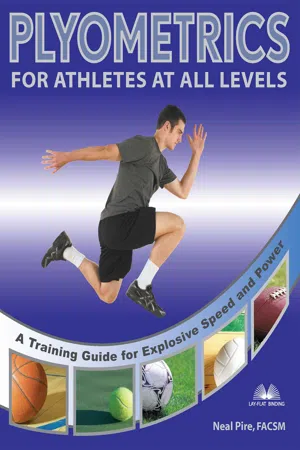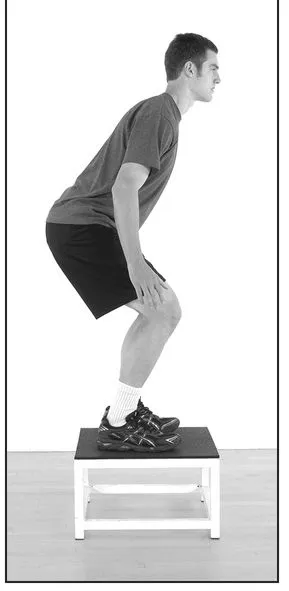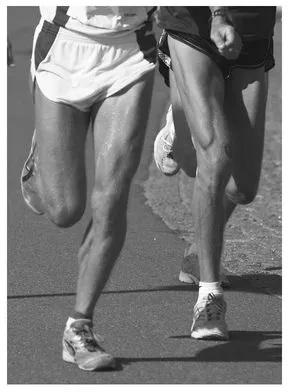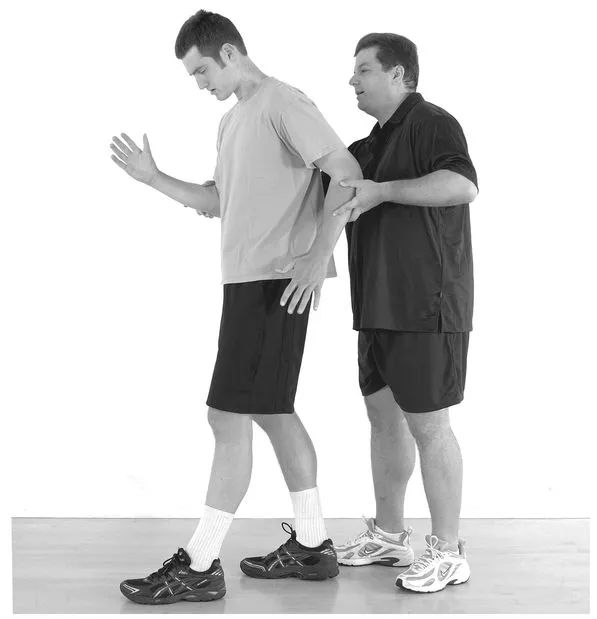
eBook - ePub
Available until 4 Dec |Learn more
Plyometrics for Athletes at All Levels
A Training Guide for Explosive Speed and Power
- 144 pages
- English
- ePUB (mobile friendly)
- Available on iOS & Android
eBook - ePub
Available until 4 Dec |Learn more
About this book
RAISE YOUR GAME TO A HIGHER LEVEL
Successful athletes combine great skill with explosive power. If you want to improve your skills: practice, practice, practice. If you want to improve your power: do PLYOMETRICS.
RAISE YOUR GAME TO A HIGHER LEVEL
Successful athletes combine great skill with explosive power. If you want to improve your skills: practice, practice, practice. If you want to improve your power: do PLYOMETRICS.
With over 70 exercises specially designed to enhance your speed, power, jumping and agility, Plyometrics for Athletes at All Levels gives you the winning advantage. Whether you’re a weekend enthusiast or a professional athlete, these exercises—each of which is fully illustrated with step-by-step photos—are guaranteed to boost your performance. With this book, you quickly gain the ability to:
Shake a defender with sharper cuts
Move faster to break away from the pack
Score more by adding power to your shot
Elevate higher for soaring catches, slams ands spikes
Deliver explosive force for crushing hits
Plyometrics for Athletes at All Levels includes beginner, intermediate and advanced exercises plus 40 customized sport-specific workouts for:
Baseball • Basketball •Bicycling •Field Hockey •Football • Golf • Gymnastics •Hockey •Lacrosse •Racquetball • Rugby •Skiing •Soccer •Softball •Swimming •Tennis •Track& Field •Volleyball •Wrestling
Successful athletes combine great skill with explosive power. If you want to improve your skills: practice, practice, practice. If you want to improve your power: do PLYOMETRICS.
RAISE YOUR GAME TO A HIGHER LEVEL
Successful athletes combine great skill with explosive power. If you want to improve your skills: practice, practice, practice. If you want to improve your power: do PLYOMETRICS.
With over 70 exercises specially designed to enhance your speed, power, jumping and agility, Plyometrics for Athletes at All Levels gives you the winning advantage. Whether you’re a weekend enthusiast or a professional athlete, these exercises—each of which is fully illustrated with step-by-step photos—are guaranteed to boost your performance. With this book, you quickly gain the ability to:
Plyometrics for Athletes at All Levels includes beginner, intermediate and advanced exercises plus 40 customized sport-specific workouts for:
Baseball • Basketball •Bicycling •Field Hockey •Football • Golf • Gymnastics •Hockey •Lacrosse •Racquetball • Rugby •Skiing •Soccer •Softball •Swimming •Tennis •Track& Field •Volleyball •Wrestling
Frequently asked questions
Yes, you can cancel anytime from the Subscription tab in your account settings on the Perlego website. Your subscription will stay active until the end of your current billing period. Learn how to cancel your subscription.
At the moment all of our mobile-responsive ePub books are available to download via the app. Most of our PDFs are also available to download and we're working on making the final remaining ones downloadable now. Learn more here.
Perlego offers two plans: Essential and Complete
- Essential is ideal for learners and professionals who enjoy exploring a wide range of subjects. Access the Essential Library with 800,000+ trusted titles and best-sellers across business, personal growth, and the humanities. Includes unlimited reading time and Standard Read Aloud voice.
- Complete: Perfect for advanced learners and researchers needing full, unrestricted access. Unlock 1.4M+ books across hundreds of subjects, including academic and specialized titles. The Complete Plan also includes advanced features like Premium Read Aloud and Research Assistant.
We are an online textbook subscription service, where you can get access to an entire online library for less than the price of a single book per month. With over 1 million books across 1000+ topics, we’ve got you covered! Learn more here.
Look out for the read-aloud symbol on your next book to see if you can listen to it. The read-aloud tool reads text aloud for you, highlighting the text as it is being read. You can pause it, speed it up and slow it down. Learn more here.
Yes! You can use the Perlego app on both iOS or Android devices to read anytime, anywhere — even offline. Perfect for commutes or when you’re on the go.
Please note we cannot support devices running on iOS 13 and Android 7 or earlier. Learn more about using the app.
Please note we cannot support devices running on iOS 13 and Android 7 or earlier. Learn more about using the app.
Yes, you can access Plyometrics for Athletes at All Levels by Neal Pire in PDF and/or ePUB format, as well as other popular books in Biological Sciences & Sport & Exercise Science. We have over one million books available in our catalogue for you to explore.
Information
part one:
jumping out of the fire
dp n="8" folio="8" ? 
plyometrics: an overview
Plyometrics has quickly become one of the most popular sports-training methods on the planet. Research has shown it to be an effective way to use your body’s own anatomical and physiological systems to improve athletic performance.
In an age when shaving a tenth of a second off your 40 can be the deciding factor in getting an athletic scholarship to a Division I school or corporate firm partnership is based on your success on the golf course, it’s imperative that you do everything you can do to take your performance to a higher level and “get noticed.”
Plyometrics for Athletes at All Levels is your guide to implementing this cutting-edge training method. Run faster, jump higher and be as quick as you want to be. Whether you’re a recreational soccer player or a masters-level weekend warrior, let plyometrics be your tool for success.
In simplest terms, plyometrics are exercises that involve a jumping, leaping or hopping movement. To understand how plyometrics works, let’s take a close look at how your body operates. Muscles and tendons are similar to rubber bands. When you stretch a rubber band, you store elastic energy so that when you release one end of the rubber band, it suddenly and rapidly contracts back to its normal shorter length. But can elastic energy actually produce greater force than an active muscular contraction?
Take your hand and place it flat on a table or desk. Keeping your hand flat and still, raise only your middle finger up off the table and purposefully “slam” it down onto the table. Do it a couple of times, gauging the force with which you are “tapping” the table with your finger. Then, keeping the rest of your hand flat on the table, use your opposite hand to quickly pull the same middle finger up off the table and allow it to snap back down onto the table. Do it a couple of times, assessing the force of the finger slapping down onto the table. You can clearly see that the stretching back of the finger results in greater force generation than simply lifting and actively contracting the finger.
Plyometric activities enable a muscle to reach maximal force in the shortest amount of time. They promote quick, powerful movements using a “pre-stretch,” or counter movement, involving something known as stretch-shortening cycle, which is discussed below. By using a combination of stored elastic energy in the muscles and tendons as well as the stretch reflex, plyometric exercises increase the power of subsequent movements.
Natural Reflexes
Your nervous and muscular systems work together to generate additional force. We have all experienced going to the doctor for a physical and having our “reflexes” checked. The doctor typically uses a rubber mallet to tap the patellar ligament in the middle of our knee and, in response, our foot naturally “kicks” forward. This is known as the myotatic, or stretch, reflex. The tapping of the ligament actually stretches the patello-femoral tendon and the quadriceps muscle.
The quadriceps, like other skeletal muscles, are made up of special muscle fibers—extrafusal and intrafusal muscle fibers. The intrafusal fibers have a very specialized purpose. These unique fibers contain what are known as muscle spindles, which have spiral-shaped nerve endings that sense the degree of stretch of that muscle fiber, as well as the rate of stretch, or how fast that fiber is stretching. This is crucial because the muscle spindles respond to the stretching, or lengthening, of the muscle by signaling to your spinal cord that the muscle is being stretched. In milliseconds, a signal returns to the muscle, telling the extrafusal fibers to autonomously contract, preventing or decelerating further stretching. Consider these mechanisms a “safety valve,” sensing excessive or perhaps dangerous stretching of the muscle and almost instantaneously preventing further stretching from occurring.
So now we see that there is force resulting from elastic energy, as well as an “unconscious” contraction in a muscle as a result from stretching that muscle. What happens if we also consciously contract the muscle upon being stretched? Let’s go back to our example of your middle finger. Place the same hand back down flat on the table. Try quickly pulling the same middle finger up off the table—just as you stretch the finger back, purposefully contract the flexors of the finger to slam it down onto the table. This is what happens during a plyometric activity. It is the perfect preparation and coordination of all these tools that will result in maximal force application.
Stretch-shortening Cycle
Let’s now go back to the stretch-shortening cycle. The stretch-shortening cycle is simply the process that a muscle goes through as it stretches and then contracts during these types of movement. There are different phases of the stretch-shortening cycle. The first phase is the eccentric phase, when the muscle stretches or lengthens, thus storing elastic energy and stimulating the muscle spindles. The second phase is called the amortization phase; during this phase, signals are sent to the spinal cord and then via motor neurons back towards the extrafusal fibers. The third phase is the concentric phase, when the muscle actually responds to the previous two phases. It is during the concentric phase that the energy stored in the muscle “retracts,” increasing the force production. This phenomenon is coupled with the reflexive muscle action resulting from the stretch reflex. When you add your conscious explosive contraction, the end result is significantly greater force application than would have resulted from simply contracting the muscle.

Consider a wildlife program you’ve seen that showed a herd of zebras grazing in the grasslands of Africa. When a lion came shooting out of the tall grass, hoping to catch its next meal, the initial reaction of the zebras was to bend down quickly and only slightly before exploding away from the lion and running for their lives. This is a demonstration of the stretch-shortening cycle. The quick stretch as the zebras lowered their center of gravity (eccentrically loading their muscles) set them up to dash away from the lion (concentric phase).
An important point to keep in mind is that if the muscle is stretched and held, the elastic energy is lost and dissipates as heat. Thus any such stretch needs to be reversed suddenly and quickly in order to take advantage of this phenomenon. This can be demonstrated by squatting down before jumping, which allows the quadriceps to be stretched eccentrically so that the following concentric contraction will be stronger. If you squat down and hold the position for a second or two, and then jump, you simply can’t produce the same explosive results. Research has shown that the faster the muscle is stretched eccentrically, the greater the force will be on the following concentric contraction. The amount of tension created by stretching the muscle is dependent on the degree and the speed of the pre-stretch of that muscle.

Author Neal Pire gives Sam some pointers.
Different Types of Plyometrics
Before we get into the “howto,” let’s look at the wide array of plyometric exercises that you have at your fingertips.
Single-Effort vs. Multiple Jumps
You can perform plyometrics as single-effort or multiple jumps. Single-effort jumps are jumps that you perform once, reset and repeat for your desired number of repetitions. Multiple jumps are done in rapid succession for your desired number of repetitions. Either of these types of jumps may be performed over barriers, such as cones or hurdles, to help accelerate overall power development and enhances the lower body’s ability to decelerate and change direction explosively. They can be performed in any chosen direction, forward and backward, side to side, on a diagonal, or in multiple pre-planned or random directions to make the exercises more difficult and enhance different movement-pattern development. You can perform them for a set number of repetitions, or you can do as many as you can for a set period of time.
Skill Combinations
Skill combinations are an ideal way to make your drills even more sport-specific. They integrate an agility skill with a sport-specific movement. You do these by combining any plyometric exercise with other movement skills to increase difficulty, add variety and incorporate more sport-specific movements. Some examples: perform a counter-movement jump and immediately upon landing sprint five yards; set up a box under a basketball rim, perform a depth jump off the box and jump up towards the rim upon landing; perform a standing broad jump then immediately cut to the left and sprint for five yards upon landing. You can even combine lower- and upper-body plyometric exercises. One combination might be to execute a 90-degree jump, catch a medicine ball upon landing and immediately perform a plyometric chest pass. Your options are endless.

Jumps in Place
With these, you land in the same place that you start from. These jumps should be maximum effort and, like all exercises, should emphasize correct jumping technique and speed of movement. They’re great for teaching you optimal jumping and landing technique, as well as explosive movement.
Standing Jumps
These refer to single-effort or multiple jumps that result in moving in any one direction. They require explosive movement and are ideal for developing lower-body power. They should be done with maximum effort and should emphasize correct technique and speed of movement.
dp n="12" folio="12" ? 
benefits of plyometrics
Now that you know what plyometric exercise is and basically how it works at the muscular level, what can it do for you? Before we answer the question, let’s look at the history of plyometrics. Plyometrics is not a new fad or the latest training craze. It has a history, albeit brief, of demonstrated success in the international arena of world-class athletes.
In the early 1960s, Soviet researchers who were assigned the task of improving their athletes’ performance began promoting training programs that involved using the stretch reflex. They referred to this type of training as “plyometric,” which comes from two Greek words meaning “more” and “to measure.” They used this term to describe the greater tension that could be developed in muscles when a quick stretching phase is followed by a fast contraction.
In 1966, Soviet jumping coach Yuri Verkhoshansky, wrote about the need to find a new way of improving athletic performance. Traditional training methods that combined resistance training with a high volume of jumping exercises were becoming less effective. Verkhoshansky observed that those jumpers that spent the least amount of ground contact time (amortization phase) showed the greatest jumping performance. He concluded that optimal jumping performance needed muscles to be strong eccentrically so that they could withstand the high mechanical load during amortization. If ...
Table of contents
- Title Page
- Please Note
- part one: - jumping out of the fire
- part two: - the programs
- part three: - the exercises
- index
- about the author
- about the photographer
- Acknowledgements
- Copyright Page